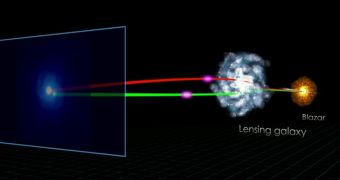Astronomers and astrophysicists were recently able to conduct the first-ever observations of a gravitational lensing event in gamma-ray wavelengths, an achievement that could allow scientists to understand the nature of gravity in much finer detail.
The highly-capable NASA Fermi Gamma-ray Space Telescope was used for these observations, which were centered on the blazar B0218+357. A blazar is a very compact quasi-stellar radio source, or quasar, at the core of a highly-active, massive elliptical galaxy located far away from Earth.
The core of the blazar is powered up by a supermassive black hole several million times the mass of the Sun. The dark behemoth releases vast amounts of energy as it gulps up matter, at a variety of wavelengths. In some cases, light from a blazar is emitted on a path that makes it visible from Earth.
In some even rarer cases, this light passes through another galaxy before it reaches us, and produces a phenomenon known as gravitational lensing. The gravitational pull of the galaxy distorts the light emitted by the blazar, as seen from our perspective, in effect creating a lens in space.
In the case of B0218+357, the light it emits from its location some 4.35 billion light-years away from Earth passes through a large, Milky Way-like spiral galaxy, located around 4 billion light-years away. The image attached to this article shows the difference between light arriving directly through the galaxy, as opposed to light bent by the object's massive gravitational pull.
In addition to learning more about gravity and blazars, the new investigation also opens the way towards probing the highly-secretive regions surrounding black holes with new methods. Additionally, Fermi data may be used to discover other cosmic setups like this one, the team behind the work says.
“We began thinking about the possibility of making this observation a couple of years after Fermi launched, and all of the pieces finally came together in late 2012,” explains the lead scientist on the new study, Naval Research Laboratory astrophysicist Teddy Cheung.
“One light path is slightly longer than the other, so when we detect flares in one image we can try to catch them days later when they replay in the other image,” adds NASA Ames Research Center astrophysicist Jeff Scargle, who was a member of the international research team.
According to a presentation held at a recent American Astronomical Society meeting, the group was able to discover playback delays of 11.46 days between gamma-ray signals released by the distant blazar. What puzzled researchers was that the delay was a day longer than the one occurring at radio wavelengths.
One possible explanation for this may be that the radio waves and the gamma-rays are not emitted from the same region within the blazar. This may account for why they have different delays, amplifications, and arrival times, especially after passing through the galactic lens.
“Over the course of a day, one of these flares can brighten the blazar by 10 times in gamma rays but only 10 percent in visible light and radio, which tells us that the region emitting gamma rays is very small compared to those emitting at lower energies,” says Stockholm University astrophysicist and team member Stefan Larsson.
Details of the new investigation will appear in an upcoming print issue of the esteemed scientific journal Astrophysical Journal Letters, the team concludes.

 14 DAY TRIAL //
14 DAY TRIAL //